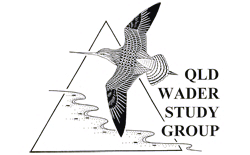In the 2017/2018 season QWSG, in partnership with the University of Queensland (UQ) co-funded the supply of 10 tracking devices for Far-Eastern Curlew. Five of these devices were the usual Platform Terminal Transmitters (PTT’s) supplied by Microwave Telemetry and using Doppler positioning to locate the birds. The other five were provided by Ornitrak and use a more accurate GPS positioning method. The project is part of a broader collaboration to collect detailed information on migratory movements and local movements on non-breeding, staging and breeding locations which will be used in recovery efforts for the species. A project with similar objectives, funded by Fudan University in China saw QWSG collaborating with the and deploying five PTT’s on Whimbrel.
For the curlew, five devices were deployed with PTT’s deployed at King Street, Thornlands (1), Geoff Skinner reserve, Wellington (2) and Toorbul (1) with a single Ornitrak device deployed at Wellington Point (1). Unfortunately the King Street device proved to be defective but the other four devices are functioning normally and generating enormous amounts of data on the birds. For Whimbrel, five PTT’s were deployed at Wellington Point (1) and Toorbul (4), all of which are functioning and transmitting data normally.
Update 17th March 2018.
The Whimbrel are all still local to Toorbul and Wellington Point and have not left yet. The curlew have started to migrate now with two of the four birds with active devices en-route already. Locally, the devices have provided detailed information on roosting and feeding areas in Moreton Bay. At Toorbul, there appear to be several roosting locations in the Toorbul area with AAD feeding locally in the southern Pumicestone Passage. However the bird clearly spent the majority of its time at or adjacent to the artificial roost.
Further South, the two birds with PTT’s fitted at Geoff Skinner wetlands, Wellington Point roost at Geoff Skinner but are regularly crossing Moreton Bay to feed on the shoreline of Peel Island and near
Dunwich. AAJ, was a sub-adult bird and while we don’t expect that one to migrate we will learn an enormous amount about local movements over the coming year as he moves around the local area. AAK has now migrated north and AAH is expected to leave Moreton Bay any time now.
Both AAD from Toorbul and AAK from Wellington Point left Moreton Bay between the 6th and 8th March and took almost identical paths north along the Queensland coast to Cape York. Both birds then headed north, over Papua New Guinea towards Guam before turning westwards towards the coast of Asia.
AAD is now on the east coast of Taiwan having arrived there on the 15th March, taking approximately 7 days from Brisbane. AAK moved further north and is staging near Rudong in China, also arriving on the 15th March after 7 days of flying. AAH, the bird with Ornitrak device is expected to migrate soon and I’ll provide more information in the next update. The map on the left shows the migration track to date.




